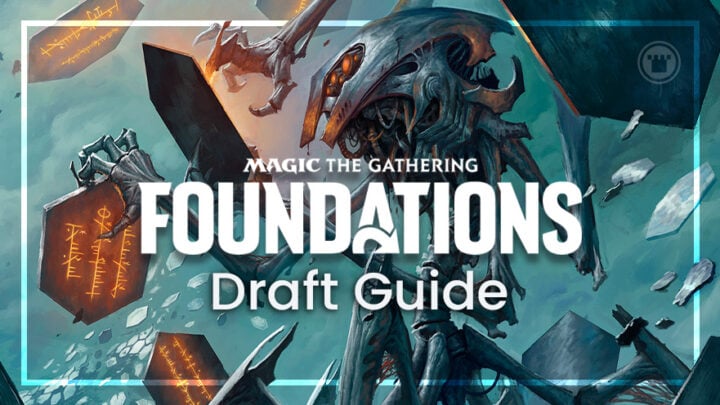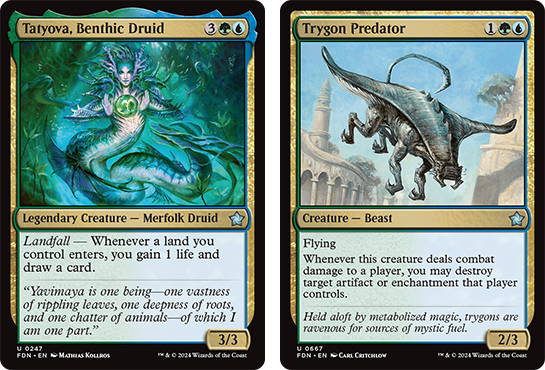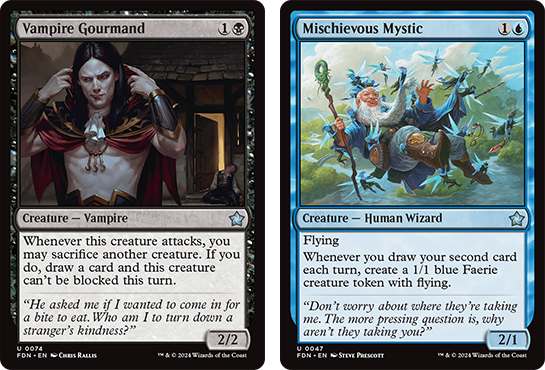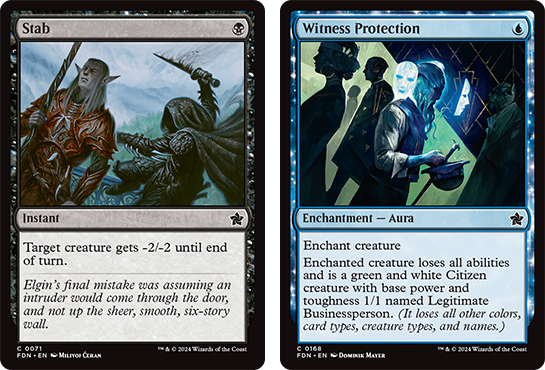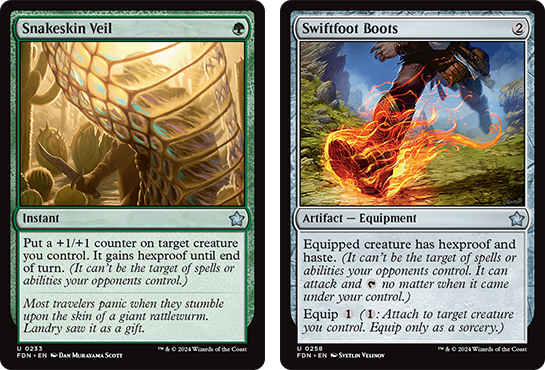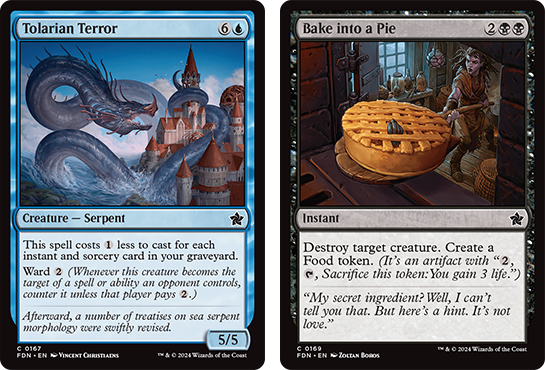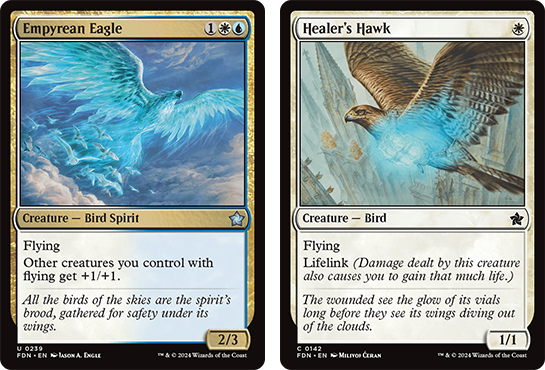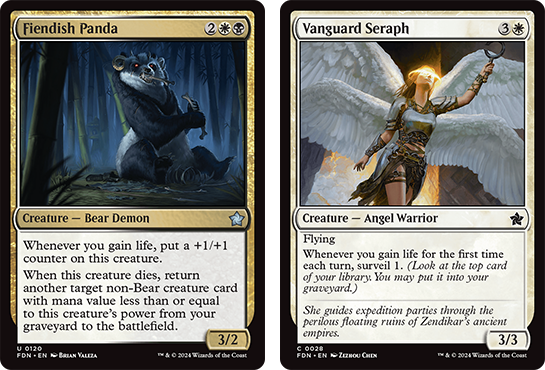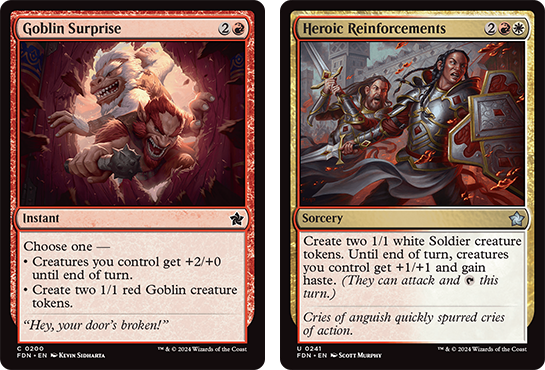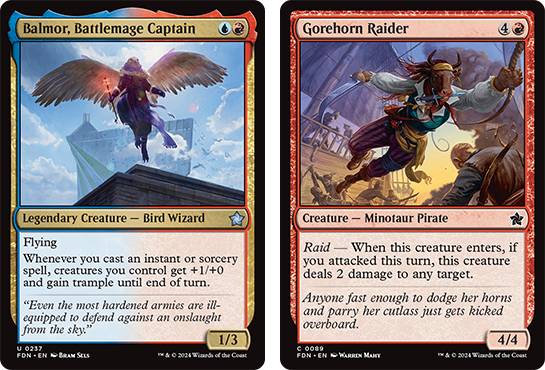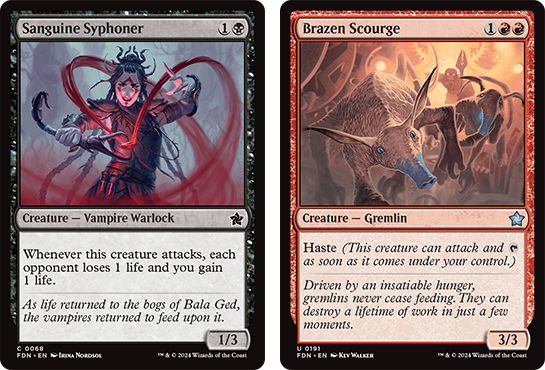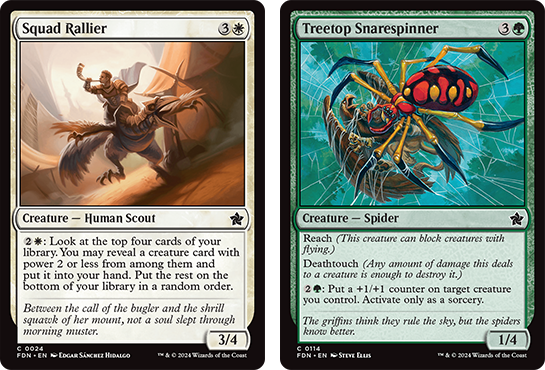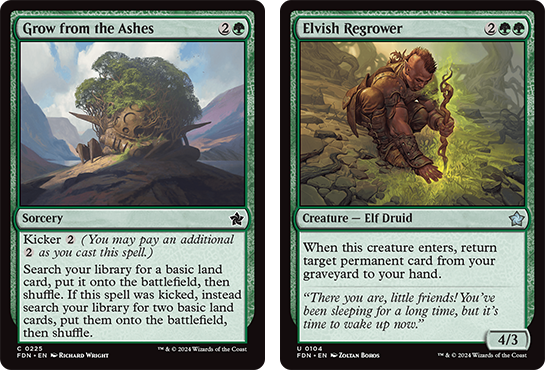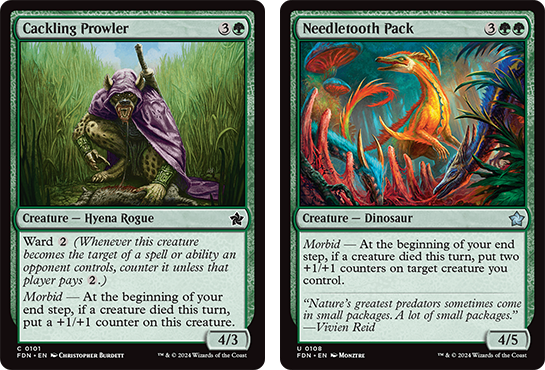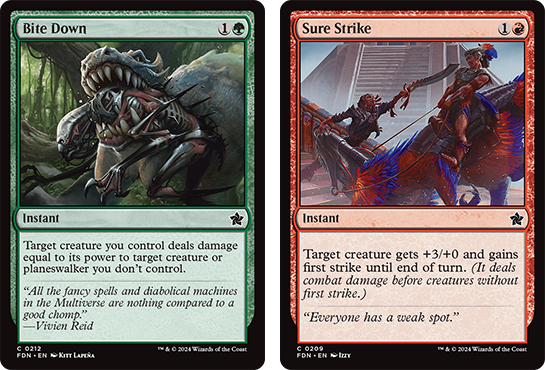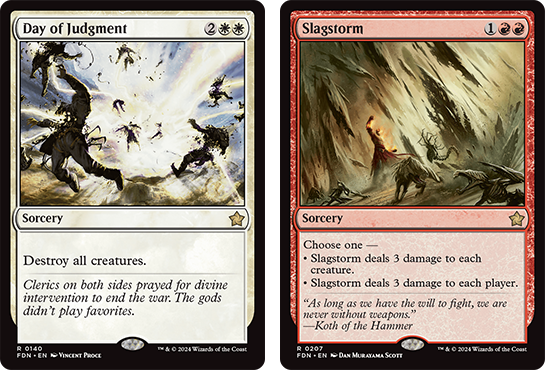As the name implies, Foundations aims to redefine and reaffirm the “default” gameplay and ideas of Magic.
This modern take on a Core Set definitely seems like a Constructed-first product – understandable, given Standard players will be living in its shadow until 2029! But that also implies that Foundations sealed product will have a long run in stores, and that “basic gameplay” idea also has value as an introductory or refreshing Limited experience.
I’m not about to pass up the chance to draft a new format just because it’s got more of a “vanilla” feel than Duskmourn or Bloomburrow. Let’s dig into this Draft Guide and find out what kind of agenda Foundations is setting for Magic’s next five years!
SHAPE OF THE FORMAT
First thing to take note of if you’re browsing the cardlist at home – or if you’re trying to quickly search up what instants are available for a certain color mid-match – is that only about half of Foundations cards actually show up in your draft boosters.
Hundreds of cards (those with collector numbers after #361) are only printed in the supplemental Starter Collection and Beginner Box products. But the decision was made to print them with the same set symbol and classify all of them as Foundations, perhaps to avoid confusion about their Standard legality. But it makes things much MORE confusing from a Draft perspective, because if you are looking at cards on Magic Arena (or most card databases), it’s not obvious that say, Tatyova, Benthic Druid is draftable while Trygon Predator is not.
As for how the cards in the draft boosters shape gameplay: the data suggests games are lasting longer than most other recent sets, but it’s not due to a lack of early tempo. There’s plenty of impactful one- and two-drop creatures here, including engines like Vampire Gourmand and Mischievous Mystic which can bury you swiftly if not checked.
This also hasn’t felt like a passive or defensive meta, as there are enough flyers and tricks (and Rogue’s Passages) to help convert board position into damage. Instead, it’s the quality and availability of cheap interaction that is helping stymie early momentum, as most games open with a rapid series of one-for-one trades before anything sticks to the board.
Stab, Burst Lightning, and Witness Protection are extremely effective one-mana staples, while white and green only need a mana more to cast their best common answers. Other than Stab and Abrade, almost all the removal spells scale up excellently to cover bigger creatures, which really helps you appreciate Snakeskin Veil and Swiftfoot Boots after a few drafts.
At the big picture level, all I’ll say is that this surplus of efficient removal has made it very very hard to dominate early game with raw tempo, as your opponent can likely respond and pick apart whatever cheap creature rushdown you had cooking. Defensively it’s almost similar – reminding us to commit seriously to drafting early blockers if you want to survive to reach the mid or late-game with a slower deck.
UNEVEN COM-PAIR-ISONS
Being a back-to-basics set, Foundations seems designed around mono-color or two-color draft decks.
More fixing than some people might expect for a “basic” set with very few multicolor cards, but less fixing than others might hope for compared to recent averages. This is certainly the first time I can remember that I’ve had more decks end up in just one color than in three or more!
Two color decks are still in the majority of course. But it seems like the key effects that support each archetype are divided more strictly between the colors. For instance, black has a near-monopoly on sacrifice outlets and self-mill, green on +1/+1 counters, blue on second-draw triggers, etc.
But the lack of secondary access to these key effects in other colors means that cards from either which lean into that synergy start to feel like committed two-color draft picks. It’s much harder to get full value out of green’s Morbid cards or white fodder like Helpful Hunter if you don’t combine them with black sac outlets, or maximize blue flashback spells and Tolarian Terror outside UB.
While I would say that any color can be the backbone of your draft deck depending on what cards you find in pack one, this uneven dependency on certain color-specific mechanics means some “base colors” feel more constrained in where they can go through packs two and three.
It doesn’t help that some of these color pairs don’t feel like they offer enough real synergy to actually be the foundation of a deck. The end result is a metagame which feels very skewed in the drafting phase, if not quite as unbalanced in the games themselves.
Black in particular seems to be hotly contested, as it has effective pairs with any color and some excellent common interaction. This is something to watch out for, as more than once I’ve found myself opening on three or four solid black picks only to be forced out of that lane as the remaining packs are swiftly plucked bare of any black spells.
Blue and red seem consistently available by comparison. Not because those colors lack quality cards, I would say, but because the quality is very inconsistent. This can also lead to traps, as it appears plenty of UR cards are there to indicate an open lane – but there may not be an opening for crucial removal spells and value engines. Draft with caution!
ARCHETYPE SUMMARY
WU: Flying Tempo
Get a couple of early Empyrean Eagle and there’s nothing but blue skies ahead for you for the rest of the draft! The cast of flyers in this set are just individually strong, making up for lower power with lifegain, card selection and other useful abilities.
Tack on white’s team-pump spells which usually convert directly into damage, and some very reasonable instant interaction, and you’re perfectly set up to force opponents into a race and then trip them up at the finish line.
White-centric builds do have the option to throw in the lifegain subtheme with Ajani’s Pridemate and the like; Healer’s Hawk and Dazzling Angel are two of the better sources of lifegain anyway. If you’re more in base blue, then you’ll naturally be playing a slower gameplan, saving your mana to disrupt opponents with countermagic and Run Away Together while your flyers apply a reliable clock on their life.
If you’re finding your air attack too slow or too feeble to punch through enemy flying blockers, this deck can make good use of equipment like Adventuring Gear, Goldvein Pick, and Quick-Draw Katana to help make your birds a bit more threatening.
WB: Lifegain Midrange
One of the strongest archetypes in the format – not only because both these colors are frontrunners for general card quality and access to key effects, but because this theme actually gets a weirdly deep pool of support cards compared to anything else in Foundations. There are a ton of good cards which can incidentally gain life for just playing normally, both in black and white and with significant overlap into neighboring themes like cats or sacrifice.
Even better, you actually have a ton of payoff uncommons to hunt for, many of which will be exclusively desirable to this deck. Ajani’s Pridemate is the obvious standout, but there’s also Midnight Snack, Vanguard Seraph, Cat Collector, plus the strong gold uncommon Fiendish Panda. In a format this prone to long, attrition-based matches, there’s ample opportunity for random points of life to really buy meaningful time, and for the incremental value generated from these cards to take over games.
These colors are also well-positioned to play a recursion-heavy game, slowing down the pace with removal and a token wall and then feeding Reassembling Skeletons to Ravenous Amulet, or bringing back high-value threats with Zombify and Macabre Waltz until enemy removal runs out.
UB: Threshold Control
Threshold is really making a comeback in Draft lately, first with the UB rats in Bloomburrow and now this. Although if you’re looking at battlefield effectiveness, then Foundation feels more like the comeback from Bloomburrow’s tepid attempt at the archetype.
Luckily here the better fortunes of black cards overall have buoyed up the pairing, as has increased access to card draw. Being able to draw more cards faster obviously helps get more of them into the graveyard, which helps make up for the lack of actual self-mill effects. At least the ones we do get (Gutless Plunderer, Cephalid Inkmage, Lightshell Duo and Billowing Shriekmass) are all solid-to-great creatures. Dreadwing Scavenger and Strix Lookout also contribute with their looting abilities, which have additional synergy with blue’s “second draw” subtheme.
The funny thing is, only one common and three uncommons actually benefit directly from reaching seven cards in the graveyard – and three of them are among those graveyard-fillers themselves. But that little boost of power does go a long way in the humble Foundations format, and it should be enough to either win through evasive attacks or stall to land your high-cost haymakers.
WR: Weenie Aggro
This is another pairing where the lack of strong archetypal direction makes things a bit weird. Token creation is a prominent mechanic throughout every color in Foundations, and white has a near-monopoly on the team-pump effects that reward building wide boards.
Red’s card pool seems weirdly devoid of incentives to go wide; it’s like the designers accidentally filled those slots with extra Prowess and Ferocity cards instead. Goblin Surprise is the major exception, being the perfect option-select spell for this archetype, and obviously Heroic Reinforcements is also a great fit, but that’s a shorter list than expected.
I think we have to take this lack of enthusiasm for team-pump as evidence RW is not meant to focus on that style so much as leverage it where it’s convenient. Red’s actual best commons are strong in a more generic aggro way: Burst Lightning, Goblin Boarders, Sower of Chaos, Gorehorn Raider. So unless the synergies all fall in your lap in the draft, it’s best to aim for a generic aggro gameplan. Combine cheap creatures with strong tricks and removal to keep combat damage flowing your way as long as possible, then lay on a bunch of burn spells and ping effects to finish things off.
UR: Counter-Burn Control
I’m used to calling these sorts of decks “spellslinger tempo”, and the presence of powerful prowess cards like Balmor, Battlemage Captain, along with TWO one-mana burn spells, does seem like the basis for a more explosive and aggressive archetype.
But in practice that just does not seem to be how my games play out, either for my own UR decks or my opponents. I blame the lack of focused themes again: besides Balmor (who is a kill-on-sight target for the format’s many removal spells) the handful of other creatures who synergize with instants and sorceries are very bad at actually attacking.
2/1s like Firebrand Archer and Elementalist Adept will almost never find a good trade in a set with so many tokens. Crackling Cyclops or Lightshell Duo fare a little better, but I hate having my biggest creatures still depend on me committing combat tricks to perform well – you’re risking a game-ending blowout at the hands of enemy removal every time.
Tolarian Terror and Gorehorn Raider end up being far more effective pillars for UR than the obvious spellslinger cards. Just focus on controlling the board, sculpting your hand, and chipping in with flyers until either they run out of life or creatures.
BR: Sacrifice Control
Again, some drafters may disagree with me over the decision to label this a “control” deck. The mechanical overlap in this color pair includes raid triggers and aristocrats-style sacrifice effects. There’s a ton of cheap, efficient burn and discard, plus enough menace, deathtouch and combat tricks to make blocking a headache. Surely this is an aggro archetype!
As with UR, I’ll believe in the aggro line once I see it work out in games. But for these colors in particular, trying to break through consistently with ground attacks and get that early damage to stick feels like an uphill climb. These colors have only three non-rare creatures below four mana which both attack for damage and survive Stab (and two are uncommon).
This makes it almost impossible to be proactive without spending cards – either you use tricks and removal to clear a path for your fragile attackers, or you sacrifice weaker creatures to try and get the strong ones through, or you simply accept trades with blockers as the cost of doing business.
So if you’re locked into a battle of attrition, and your stubby little attackers don’t get much damage in per turn when you do win, and your main mechanism for taking over games is mana-intensive value loops like sacrificing Reassembling Skeleton… you might as well embrace being a control deck. At the very least, don’t mistake Hungry Ghoul for anything more than a C- filler creature.
WG: Go-Wide Aggro
Even in a format where token-creation has been thoroughly democratized, it turns out GW still stands for “Go Wide”. These are the two best colors in Foundations for one- and two-drop creatures, AND the best for combat tricks, so it’s fairly easy for this deck to get board advantage early.
If you happen to fall behind, lifegain and token generation give you the tools to slow opponents down while still accumulating power on board, until eventually their trades start to look less favorable. It’s almost a superpower in a set where other color combos can really struggle to stabilize off a bad start.
Once you are at least stable on board, you can rely on token generators and team-wide pump effects to give you inevitability that other small-creature decks in the format lack. Common mana sinks like Squad Rallier and Treetop Snarespinner are also genuine game-winners in a board-stall situation, often forcing opponents to make the first move and offer you your choice of trades.
Equipment gives you another way to maximize the value of surplus tokens and mana in long games. I seriously think a juiced-up Healer’s Hawk will flat out beat a majority of draft decks (at least with enough backup from Snakeskin Veil).
UG: Landfall Ramp
To be honest, I’m not convinced that Foundations actually has a UG draft archetype at all. I tried to force it for days at a time without really coming close to assembling it, and I don’t even remember having played against a straight-up UG opponent – just a smattering of Temur or Sultai decks.
The presence of Tatyova, Benthic Druid as our two-color uncommon does suggest a traditional ramp deck which relies on landfall value and big haymakers to outscale opponents. The issue is that none of our mono-color cards seem that interested in supporting that plan!
Only four other cards have landfall – a five drop, a six drop, a red card, and an equipment which historically shines in hyper-aggressive decks. There’s not that much opportunity to ramp either. Llanowar Elves is highly contested both in picking and by removal in game, while Grow from the Ashes and Burnished Hart feel extremely risky to commit to on-curve, especially going second.
Foundations isn’t even that generous with payoff spells that can scale with a significant amount of extra mana. Genesis Wave feels like the standard you’re aiming for, and it is at least the kind of rare that will frequently make its way around the table to you. But beyond that it’s only really Spectral Sailor, Meteor Golem and loops of multiple Elvish Regrowers (ideally in tandem) that produce enough juice to be worth the squeeze.
BG: Morbid Midrange
Green in Foundations has some surprising similarities to white, both in power level and its portfolio of effects. There are things unique to each color, of course, but the overlap allows green to kind of swap in for white’s place in the WB sacrifice deck without really changing much else. Your ability to generate tokens as sacrifice fodder is much the same, while a loss of reliable white removal is covered for by green’s more formidable blockers (and hopefully a few extra slots of black removal).
Some of those big bodies also naturally provide extra value over time, whether it’s Elfsworn Giant churning out tokens or Cackling Prowler and Needletooth Pack growing your Vampire Gourmand and/or Nighthawk. The gold uncommon, Wardens of the Cycle, feels like a rare in this format and can easily take over games if not removed – the incremental lifegain is particularly precious for a deck which should have inevitability in most matchups.
A slightly different approach is to use black as the second color in a base-green Inspiring Call deck, where Hungry Ghoul can finally reach its true potential alongside Infernal Vessel, Stromkirk Bloodthief and the green Morbid creatures. Black’s access to flyers can also make it easier to get aggressive in these decks, as opposed to outgrowing the entire enemy ground force before you can attack.
RG: Ferocity Aggro (a.k.a. “Power 4 matters”)
Normally I wouldn’t have said we need another Draft format dominated by Snakeskin Veil so soon after Thunder Junction. But if you’re serious about doing a set that embodies the core identity and gameplay of each color, then it seems impossible to leave out the little tube of instant-speed glue holding green’s entire strategy together.
We’re definitely following that “stompy” playbook here. First accelerate mana using mana dorks or land ramp (or at least hit all your land drops) so you can play bigger creatures than them. Then use your bigger bodies to apply pressure in combat, knowing they will have to multi-block or commit interaction first to even up the unfair fight. When they do, blow them out with cheap tricks like Veil, Giant Growth and Bite Down to preserve your big guys and cripple their board.
Adding red doesn’t really tempt me away from this style of play, but it does make you deeper in key areas. Ruby, Daring Tracker gives us another precious mana accelerant, Sure Strike is a hyper-effective trick for helping large creatures beat multi-blocks and deathtouch, while Slumbering Cerberus and Goblin Boarders give us reliable access to that four power breakpoint earlier in the game.
You can also benefit from the increased flexibility of red’s removal, flyers and direct damage, which can save you in spots where a mono-green deck might not have the tools. Overall, it’s hard to go wrong with an archetype which rewards you for playing already-strong proactive cards.
A STRONG FOUNDATION
At this stage I doubt Foundations is going to make my all-time fave formats list, but I can’t deny that it does achieve that which it sets out to do. It paints a recognizable vision of Magic’s core gameplay and color pie, even as it introduces an updated palette of staple cards and evergreen mechanics. If a new generation of Magic players is going to cut their teeth on a set like this, then they will be getting a decent perspective on what the game has traditionally been like – and thus a good head start on exploring Magic’s labyrinthine back catalogue.
As a habitual Draft fiend, I do find the longer average game length refreshing compared to other recent sets. But when you also consider the lack of significant value engines, powerful lifegain and removal suites, and the influence of extra rare slots in Play Boosters, it does feel like maybe too much is stacked against low-curve aggro decks.
Maybe I’ve just had rotten luck running into maindeck Slagstorm and Day of Judgment, but even the more rare-blessed aggro curves I’ve had run into a lot of trouble pushing past the various tokens and food and flying lifelinkers. But adaptation to the format is a key part of Limited, and even red has ways to beef up its endgame with threats like Shivan Dragon. I just think it’s weird for a “foundational” Magic experience to be so skewed away from the game’s most historically prominent strategy.
At least red decks are still cleaning up in Standard right now, so if you get desperate there’s an easy way to get your fix of cheap and cheerful aggro. For anything else, Foundations Draft has you covered with a welcome dose of classic MTG flavor.

Tom’s fate was sealed in 7th grade when his friend lent him a pile of commons to play Magic. He quickly picked up Boros and Orzhov decks in Ravnica block and has remained a staunch white magician ever since. A fan of all Constructed formats, he enjoys studying the history of the tournament meta. He specializes in midrange decks, especially Death & Taxes and Martyr Proc. One day, he swears he will win an MCQ with Evershrike. Ask him how at @AWanderingBard, or watch him stream Magic at twitch.tv/TheWanderingBard.

